Bridging of Solder

Smaller mistakes create a huge problem, in the end, one of them is solder bridging.
In the process of PCB soldering, when we connect the circuit by solder, some of them will contact the other, this will cause the circuit to short.
This can create huge damage if we don’t care about it.
This circuit is not connected electrically but it can be done by mixing or contacting solder.
Usually, you have excess solder on a very small area or joints.
To prevent this fault you should have to melt those areas having short solder with a soldering gun to the extent where it fully becomes a fluid then you can easily break the path.
If the solder is too hard you can use a solder sucker to remove the solder.
It’s better to use solder keeping in view the thickness and size of PCB and components.
Excess of Solder:
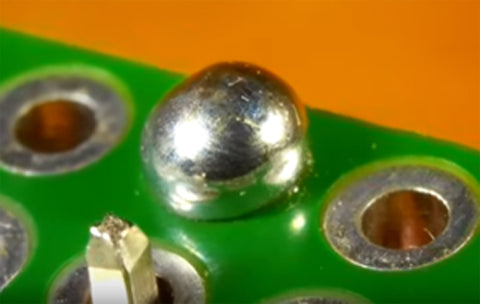
Mostly for the beginner, it’s a huge problem that they use an excess of solder during PCB soldering.
This may results in short circuits, wastage of solder, and cause bridging of solder which causes many other problems to the PCB.
In the soldering process, when the excess solder falls on the pin, it can not ensure the connection of the joint, which may be that the joint remains loose and causes problems.
Much solder may wet the pins and pads of the circuits.
So try to use less solder as required for the joints and fully sure that the joints fixed.
Using small solder risks of short circuit and many other problems are reduced.
It’s better for us to be safe than sorry.
Balling of Solder:
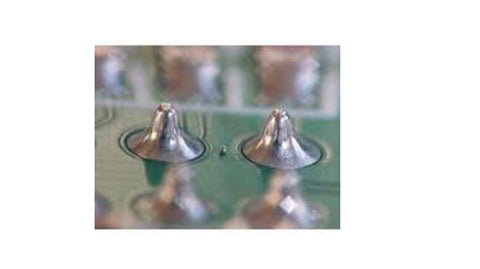
Balling of solder is also a huge problem for PCB soldering.
In balling of solder when printed circuit boards come near to moisture surface then water vapors will start flow with the heat, and then producing a wave of solder onto the hole of the PC board.
Those holes having solder on them produces a wave of solder on the backside of the PCB.
Another damage is when the amount of flux is increased, it may cause the evaporation of the components in flux.
When there is an excess of flux more will evaporate at a larger temperature and the solder will move out from the tin bath.
We should be aware of this fault and try to put the printed circuit away from the moisture place.
Heat loss analysis
Many electrical and electronic components or devices get heated much when they were working at full capacity.
If we already cannot check it then they may cause overheating of the component and maybe for the PCB creating many problems.
Heating up of the components during working at full capacity again and again may cause a reduction in the life of products.
To reduce such fault we basically used a Heat Sink to which sense heat and absorb the extra heat from the device.
We used an SMD heat sink which is soldered at the end of the PC board connects with the circuit which will reduce the risk of overheating by absorbing the extra amount of heat.
Tombstoning
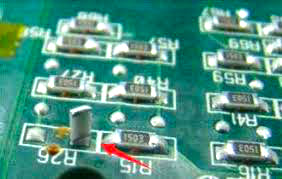
Tombstone components are basically surface mount components, like resistors, inductors, and capacitors, in which one side is lifted off from the pad.
When the solder connects to both pads then the wetting process starts, but if the solder cannot wet the one pad, then one side of the component will tilt on his side, just as a tombstone, that’s why it is called tombstoning.
During reflow of the soldering one solder on one side pad would melt the other pad, this fault would happen automatically.
The main reasons are the lack of thermal relief design and the unequal thickness of the path that connects the pads.
So in order to remove the fault, the designers must know the direction of the wave during the design of PCB during wave soldering.
Pins and connector connections:
Pins and connectors connection is the most important part of PC boards which is basically operating the whole circuit.
If the pins are not placed in the correct way may cause damage to the connector.
To get rid of these types of faults, we can use a tool named a pattern-matching tool, it basically locates the pattern of a specific group, hence it is used to indicate the pattern matches the specific pattern /location are not.
So a complete look at the pins and connector connection will provide a better way to get rid of this problem.
Surface mount:
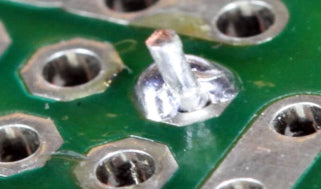
It is also known as insufficient wetting.
SMD components would arise a problem if they are not having sufficient wetting.
Then solder on the pins will fail to flow onto the pads as pin heated instead of pads, which would result in miss soldering or failure of soldering, which means the device components would automatically fall down.
To get rid of this problem, we heat the solder pads with the soldering gun then we apply more and more solder until it starts flowing and melting with the solder already having on the pins.
So insufficient wetting is also a huge problem for the PC board manufacturers.
Skip solder
A joint that does not join up with solder is basically a skip solder.
When the solder is skipped over surface mount pads then skips solder happens which can result in an open circuit.
It may be a manufacturer’s fault that they forget to complete the circuit or every joint on a software design.
It could result in an open circuit in which the whole circuit will not work in a proper way.
This problem could be solved, firstly we put analysis on the software design, after that, solder the circuit properly, then there will be no joint or path of the circuit be missed.
Lift pads
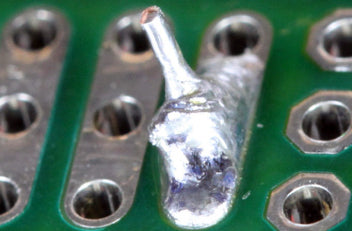
When an excess of heat and solder were given to the surface of PC boards, then a pad of solder becomes lifted on it. These pads are the lifted pads.
And the pads become lifted on the back of the PC boards.
Therefore the manufacturers will try to move the components because the joints cannot be seen during operations which can result in tilted pads.
During lifted pads, PCB boards will not work in a proper way so the PCB may be damage.
During soldering try to provide small heat and solder as required for PC boards for soldering.
In such a way we get rid of this problem.
Pins and blowholes:

Pins and blowholes can easily be detected as they appear a hole of solder on the PC boards clearly.
Pins and blow holes give an idea of the size of the hole generally pins hole is a small hole but the blowholes are the larger.
In the process of wave soldering, no good soldering skills will lead to pins and blowholes.
In the process of soldering the moisture on the PCB is heated, and when moisture becomes in a molten state it will leave the solder.
Holes are produced when moisture gas starts leaving when the solder joint is heated.
Preheating of PC boards will remove the moisture early and having a very small thickness of copper plate near to about 20-25um in the holes.
In this way, the problem is reduced.
Chemical flow
The leakage of chemical fluid is a big problem during soldering which can cause severe damage to the circuit.
This problem arises in the production process of printed circuit boards, and trace elements will not be removed from the circuit boards.
The components we use in the circuit may produce this kind of chemical substance inside, which leads to the damage of the components and PC board.
By thoroughly cleaning the PC board at the end of manufacturing to remove the chemical substances in the circuit, we eliminated this type of fault in this way and got a suitable PC board for use.
Faulty wires breakage:
In the process of analyzing the circuit, we will find the problem of wire breakage, which is also a major problem of circuit opening.
If these broken wires come into contact with another wire, it will cause a short circuit and the whole circuit will be damaged.
We should keep in view the design and look at the circuit to make it clear.
If we don’t care about it, this will create huge damage during working.
Insufficient heat
This is also called a cold joint
During soldering when sufficient heat would not be given to the joints of PC boards would result in poor conduction or may not any conduction.
When the soldering gun cannot give proper heat to the joint, the result will be harmful to the PC board.
To prevent these problems give specific heat to every joint so that no problems arise.
Keep in mind this fault for a proper and good connection to prevent the circuit from damage.
